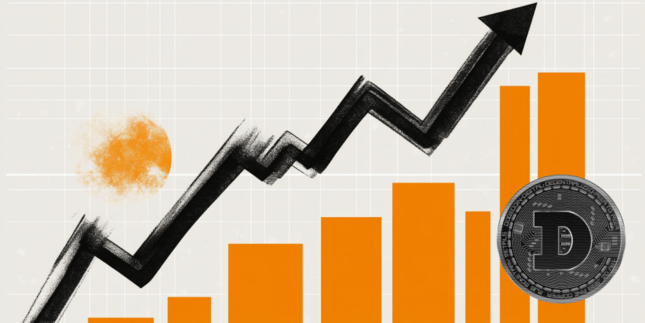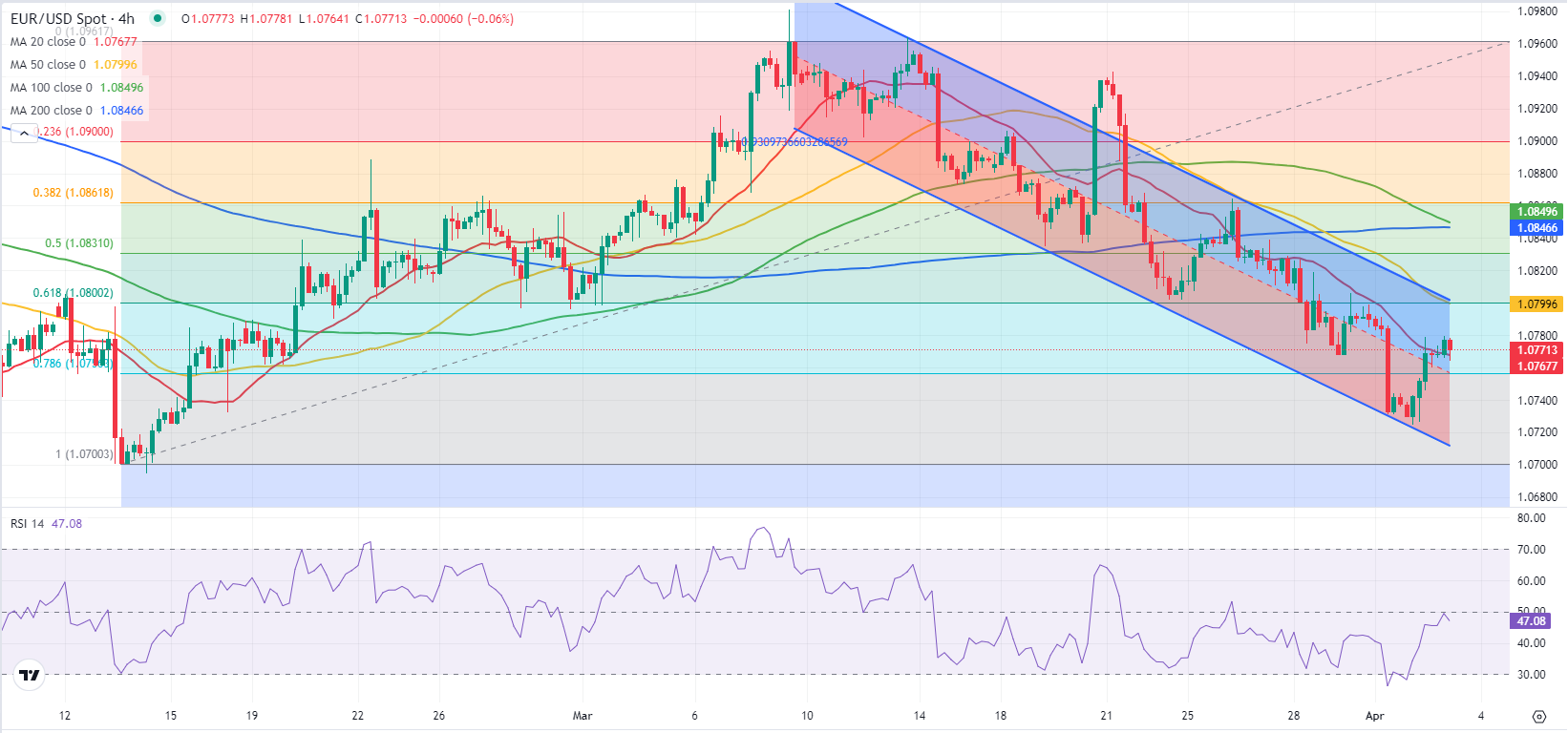- EUR/USD holds steady above 1.0750 after closing in the green on Tuesday.
- EU inflation and high-tier US data could drive the pair's action on Wednesday.
- The technical outlook suggests that the bearish bias stays intact.
EUR/USD gained traction and closed in positive territory on Tuesday after touching its weakest level since February 15 below 1.0730. The pair seems to have gone into a consolidation phase above 1.0750 early Wednesday ahead of key data releases.
Euro price this week
The table below shows the percentage change of Euro (EUR) against listed major currencies this week. Euro was the strongest against the Swiss Franc.
| USD | EUR | GBP | CAD | AUD | JPY | NZD | CHF | |
| USD | 0.20% | 0.52% | 0.41% | 0.33% | 0.20% | 0.30% | 0.74% | |
| EUR | -0.20% | 0.33% | 0.22% | 0.14% | 0.00% | 0.10% | 0.54% | |
| GBP | -0.53% | -0.33% | -0.12% | -0.19% | -0.34% | -0.22% | 0.21% | |
| CAD | -0.41% | -0.21% | 0.10% | -0.08% | -0.22% | -0.10% | 0.33% | |
| AUD | -0.33% | -0.14% | 0.19% | 0.07% | -0.14% | -0.04% | 0.41% | |
| JPY | -0.20% | 0.03% | 0.33% | 0.23% | 0.17% | 0.11% | 0.55% | |
| NZD | -0.31% | -0.10% | 0.24% | 0.12% | 0.03% | -0.12% | 0.38% | |
| CHF | -0.73% | -0.50% | -0.17% | -0.31% | -0.36% | -0.51% | -0.39% |
The heat map shows percentage changes of major currencies against each other. The base currency is picked from the left column, while the quote currency is picked from the top row. For example, if you pick the Euro from the left column and move along the horizontal line to the Japanese Yen, the percentage change displayed in the box will represent EUR (base)/JPY (quote).
The renewed US Dollar (USD) weakness helped EUR/USD stage a rebound during the American trading hours on Tuesday. Although there was a negative shift in risk sentiment, investors refrained from betting on an extended USD rally.
Eurostat will release the preliminary inflation data for March.
European Central Bank (ECB) policymakers made it clear that they intend to lower the policy rate in June. Unless there is a significant downside surprise that could revive expectations for an ECB rate cut in April, the market reaction could remain limited. Investors expect the Harmonized Index of Consumer Prices to rise 2.6% on a yearly basis in March, matching February's increase.
Later in the day, the ADP Employment Change data from the US will be watched closely by market participants, who forecast an increase of 148K in March. A print at or below 100K could trigger a USD selloff with the immediate reaction.
The ISM Services PMI data will also be featured in the US economic docket. Earlier in the week, the USD outperformed its rivals after the ISM Manufacturing PMI came in better than expected and the Prices Paid Index of the survey rose sharply. Hence, a similar reaction could be seen if the ISM Services PMI beats analysts' estimates.
EUR/USD Technical Analysis
The Relative Strength Index (RSI) indicator on the 4-hour chart started to edge lower after reaching 50, suggesting that buyers remain hesitant. Additionally, EUR/USD stays within the descending regression channel coming from mid-March.
On the downside, 1.0760 (Fibonacci 78.6% retracement of the latest uptrend) aligns as immediate support before 1.0720 (static level) and 1.0700 (beginning point of the uptrend).
Strong resistance seems to have formed at 1.0800 (upper limit of the descending channel, Fibonacci 61.8% retracement) before 1.0830 (Fibonacci 50% retracement) and 1.0850 (100-period and 200-period Simple Moving Averages).
Euro FAQs
The Euro is the currency for the 20 European Union countries that belong to the Eurozone. It is the second most heavily traded currency in the world behind the US Dollar. In 2022, it accounted for 31% of all foreign exchange transactions, with an average daily turnover of over $2.2 trillion a day. EUR/USD is the most heavily traded currency pair in the world, accounting for an estimated 30% off all transactions, followed by EUR/JPY (4%), EUR/GBP (3%) and EUR/AUD (2%).
The European Central Bank (ECB) in Frankfurt, Germany, is the reserve bank for the Eurozone. The ECB sets interest rates and manages monetary policy. The ECB’s primary mandate is to maintain price stability, which means either controlling inflation or stimulating growth. Its primary tool is the raising or lowering of interest rates. Relatively high interest rates – or the expectation of higher rates – will usually benefit the Euro and vice versa. The ECB Governing Council makes monetary policy decisions at meetings held eight times a year. Decisions are made by heads of the Eurozone national banks and six permanent members, including the President of the ECB, Christine Lagarde.
Eurozone inflation data, measured by the Harmonized Index of Consumer Prices (HICP), is an important econometric for the Euro. If inflation rises more than expected, especially if above the ECB’s 2% target, it obliges the ECB to raise interest rates to bring it back under control. Relatively high interest rates compared to its counterparts will usually benefit the Euro, as it makes the region more attractive as a place for global investors to park their money.
Data releases gauge the health of the economy and can impact on the Euro. Indicators such as GDP, Manufacturing and Services PMIs, employment, and consumer sentiment surveys can all influence the direction of the single currency. A strong economy is good for the Euro. Not only does it attract more foreign investment but it may encourage the ECB to put up interest rates, which will directly strengthen the Euro. Otherwise, if economic data is weak, the Euro is likely to fall. Economic data for the four largest economies in the euro area (Germany, France, Italy and Spain) are especially significant, as they account for 75% of the Eurozone’s economy.
Another significant data release for the Euro is the Trade Balance. This indicator measures the difference between what a country earns from its exports and what it spends on imports over a given period. If a country produces highly sought after exports then its currency will gain in value purely from the extra demand created from foreign buyers seeking to purchase these goods. Therefore, a positive net Trade Balance strengthens a currency and vice versa for a negative balance.
Information on these pages contains forward-looking statements that involve risks and uncertainties. Markets and instruments profiled on this page are for informational purposes only and should not in any way come across as a recommendation to buy or sell in these assets. You should do your own thorough research before making any investment decisions. FXStreet does not in any way guarantee that this information is free from mistakes, errors, or material misstatements. It also does not guarantee that this information is of a timely nature. Investing in Open Markets involves a great deal of risk, including the loss of all or a portion of your investment, as well as emotional distress. All risks, losses and costs associated with investing, including total loss of principal, are your responsibility. The views and opinions expressed in this article are those of the authors and do not necessarily reflect the official policy or position of FXStreet nor its advertisers. The author will not be held responsible for information that is found at the end of links posted on this page.
If not otherwise explicitly mentioned in the body of the article, at the time of writing, the author has no position in any stock mentioned in this article and no business relationship with any company mentioned. The author has not received compensation for writing this article, other than from FXStreet.
FXStreet and the author do not provide personalized recommendations. The author makes no representations as to the accuracy, completeness, or suitability of this information. FXStreet and the author will not be liable for any errors, omissions or any losses, injuries or damages arising from this information and its display or use. Errors and omissions excepted.
The author and FXStreet are not registered investment advisors and nothing in this article is intended to be investment advice.
Recommended Content
Editors’ Picks

EUR/USD keeps losses below 1.1400 ahead of EU PMI data
EUR/USD holds losses below 1.1400 in the European morning on Wednesday. The Euro stays defensive ahead of the German and Eurozone preliminary PMI data while the US Dollar pauses its recovery mode led by Trump's backpedaling on the US-China trade war and Powell. US PMI also awaited.

GBP/USD stays weak near 1.3300, UK PMI eyed
GBP/USD is off the lows but remains under pressure near 1.3300 in early Europe on Wednesday. The pair stays weak as investor appetite shifts back toward US assets, including the US Dollar, buoyed by a more optimistic tone from US President Donald Trump. UK/US PMIs are next in focus.

Gold price sticks to intraday losses amid positive risk tone; still holds comfortably above $3,300
Gold price moves away from the all-time peak touched on Tuesday amid receding safe-haven demand. Easing US-China tensions remains supportive of the risk-on impulse and weighs on the XAU/USD pair. The downside for the commodity seems limited as the USD bulls seem reluctant amid Fed rate cut bets.

Dogecoin lead double-digit gains across meme coins, with Shiba Inu, PEPE and BONK skyrocketing to new monthly highs
Top meme coins Dogecoin, Shiba Inu, PEPE and BONK lead the meme coin sector with double-digit gains on Wednesday following the crypto market recovery.

Five fundamentals for the week: Traders confront the trade war, important surveys, key Fed speech Premium
Will the US strike a trade deal with Japan? That would be positive progress. However, recent developments are not that positive, and there's only one certainty: headlines will dominate markets. Fresh US economic data is also of interest.

The Best brokers to trade EUR/USD
SPONSORED Discover the top brokers for trading EUR/USD in 2025. Our list features brokers with competitive spreads, fast execution, and powerful platforms. Whether you're a beginner or an expert, find the right partner to navigate the dynamic Forex market.
